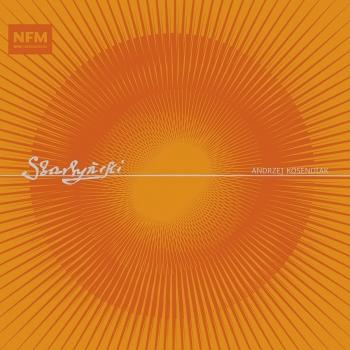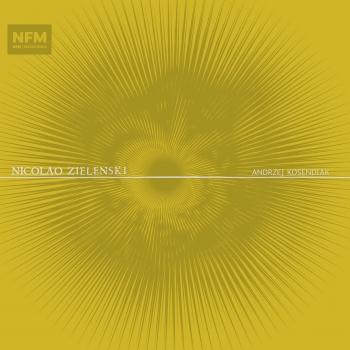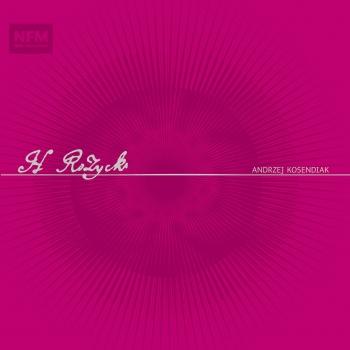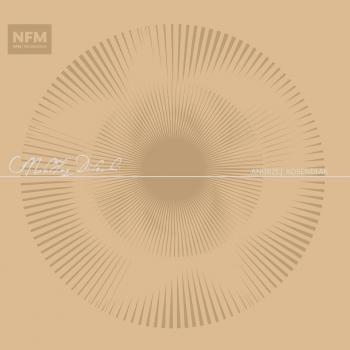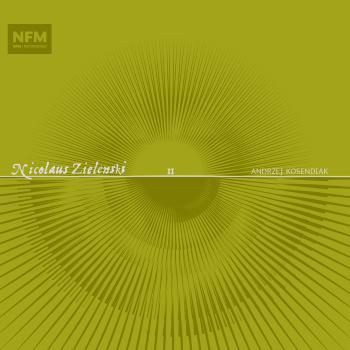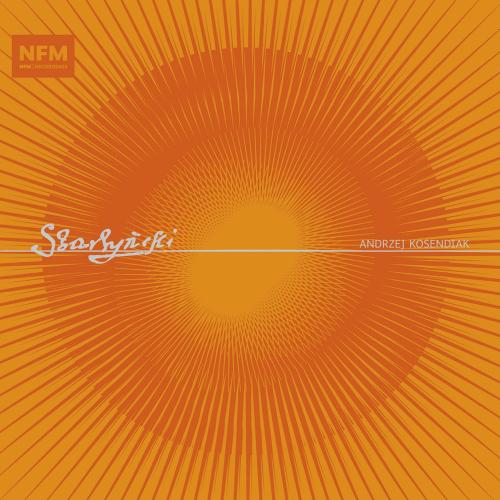
Szarzyński & Others: Works Wrocław Baroque Ensemble & Andrzej Kosendiak
Album info
Album-Release:
2019
HRA-Release:
15.11.2019
Label: CD Accord
Genre: Classical
Subgenre: Vocal
Artist: Wrocław Baroque Ensemble & Andrzej Kosendiak
Composer: Stanislaw Sylwester Szarzynski (1700)
Album including Album cover Booklet (PDF)
- Stanisław Sylwester Szarzyński (1650 - 1713):
- 1 Completorium: I. Cum invocarem 03:55
- 2 Completorium: II. In te Domine speravi 02:52
- 3 Completorium: III. Qui habitat 03:47
- 4 Completorium: IV. Ecce nunc benedicite Dominum 03:37
- 5 Completorium: V. Te lucis ante terminum 02:39
- 6 Completorium: VI. Nunc dimittis 03:48
- 7 Completorium: VII. Ave Regina 03:52
- 8 Pariendo non gravaris 05:43
- 9 Veni Sancte Spiritus 07:22
- 10 Quam felix curia 05:31
- 11 Jesu spes mea 04:53
- 12 Ad hymnos ad cantus 04:53
- 13 Trio Sonata in D Major 05:42
- 14 Litania cursoria 15:48
- 15 Praeludium primi toni 01:25
- 16 Missa septem dolorum Beatae Mariae Virginis: I. Introitus 01:25
- 17 Missa septem dolorum Beatae Mariae Virginis: II. Kyrie 01:02
- 18 Missa septem dolorum Beatae Mariae Virginis: III. Gloria in excelsis Deo (Excerpt) 00:30
- 19 Missa septem dolorum Beatae Mariae Virginis: IV. Gratias agimus tibi 02:03
- 20 Praeludium (1) 00:18
- 21 Missa septem dolorum Beatae Mariae Virginis: V. Quoniam tu solus sanctus 01:14
- 22 Preambulum (2) 00:20
- 23 Missa septem dolorum Beatae Mariae Virginis: VI. Offertorium 01:44
- 24 Missa septem dolorum Beatae Mariae Virginis: VII. Sanctus 01:41
- 25 Missa septem dolorum Beatae Mariae Virginis: VIII. Benedictus 00:49
- 26 Missa septem dolorum Beatae Mariae Virginis: IX. Agnus Dei 01:07
- 27 Missa septem dolorum Beatae Mariae Virginis: X. Communio 01:15
- 28 Missa septem dolorum Beatae Mariae Virginis: XI. Planctus de Beata Maria Virgine 01:46
- 29 Gloria in excelsis Deo 03:03
Info for Szarzyński & Others: Works
Stanisław Sylwester Szarzyński’s surviving output of music comprises ten compositions, whose excellent quality and attractive sound earn him a place among the most distinguished Polish Baroque composers.(...)
We do not have any archive documents concerning the figure of Szarzyński or any autographs of his works. He most probably lived during the last decades of the 17th century, though the dates of his birth and death as well
as the place or places of his activity are impossible to establish.(...)
Nearly all of Stanisław Sylwester Szarzyński’s surviving works represent the seconda pratica and are structured in accordance with the concertato style typical of the second half of the 17th century. The single (but significant) exception is the Missa septem dolorum Beatae Mariae Virginis, never previously published or recorded. (...)
Szarzyński’s solo church concertos are scored typically of the era, with two violins and continuo in the accompaniment. However, the concertos are diversified with regard to form. One of those most internally varied is the soprano concerto Veni Sancte Spiritus, setting the text of the Pentecostal sequence. (...)
The tenor concerto Pariendo non gravaris and the alto concerto Quam felix curia, on the other hand, represent regular four-movement forms which consist of alternating slow and fast sections. Here Szarzyński experiments
with ‘new’ keys that go far beyond the traditional system of church modes. The former of these concertos is written in the key of C sharp minor, the latter – in B flat minor. (...)
Another solo church concerto, Ave Regina, previously published separately, in the Łowicz manuscript constituted the last part of Szarzyński’s Completorium. This cycle is a musical setting of four psalms, the hymn Te lucis ante terminum and the canticle Nunc dimittis, followed – in accordance with liturgical requirements – by a Marian antiphon. The entire cycle is scored for four voices, two violins and basso continuo. (...)
The setting of the Litany of Loreto is an extensive one-movement work, which in the Łowicz copy was entitled Litania cursoria – a Polish-Latin hybrid, possibly referring to the cursus marianus, the so-called little office in praise of the Mother of God. (...)
Ad hymnos ad cantus is a compact composition for five vocal parts with instrumental accompaniment, written in the form of a ritornello concerto (also called a rondo concerto). The said ritornello, performed tutti and characterised by a homorhythmic texture, is performed twice in its full version, while its closing measures also serve as a recurring ‘refrain’ in the mosaic-like segment “Agite ergo”.(...)
Szarzyński’s only instrumental work, Sonata for two violins and basso pro organo, is at the same time the only surviving relic of Polish instrumental music from the second half of the 17th century. (Marcin Szelest)
Aldona Bartnik, soprano
Alexander Schneider, alto
Maciej Gocman, tenor
Radosław Kamieniarz, violin
Klaudia Matlak, violin
Julia Karpeta, viola da gamba
Krzysztof Karpeta, violone
Marta Niedźwiecka, positive organ
Benjamin Glaubitz, tenor
Aleksandra Turalska, soprano
Ferdinand Hendrich, sackbut/trombone
Hans-Martin Schlegel, sackbut/trombone
Masafumi Sakamoto, sackbut/trombone
Andrzej Kosendiak, conductor
Andrzej Kosendiak
Director of the National Forum of Music, artist, conductor and pedagogue, Andrzej Kosendiak has earned an enviable reputation as one of the most active and committed musicians and organizers of music life in Poland. He graduated from the Department of Composition, Conducting and Music Theory of Wrocław Music Academy. In 2013 he obtained the academic degree of doctor habilitatus. For many years he taught at his Alma Mater, where in 2001-2009 he was head of the Cross-Department Early Music Studies. Since 2014 he has been Professor at the S. Moniuszko Academy of Music in Gdańsk. In 2005 he became Director of the Wrocław Philharmonic and the International Festival Wratislavia Cantans.
He soon reformulated the profile of both organizations and successfully led them to their merger in 2014 into one performing arts organization - the National Forum of Music. Upon his initiative, construction works of the new venue of the National Forum of Music were commenced, and he is now the coordinator of this state-of-the-art concert hall development. Andrzej Kosendiak’s efforts led to the establishment of Society of Polish Philharmonics, of which he is now chair for the second term of office.
Of the National Forum of Music artistic ensembles, many were founded upon Andrzej Kosendiak’s initiative: NFM Choir, Wrocław Baroque Orchestra, NFM Boys’ Choir, and he also contributed to the founding of Polish National Youth Choir. Andrzej Kosendiak founded the festivals Forum Musicum and Leo Festival. Thanks to his efforts, in 2013 the Wrocław Philharmonic organized the 27th Congress of the International Society for the Performing Arts, attended by around 400 delegates and guests from all over the world. He is one of the authors of academies of early music held annually in Wrocław, combining concerts with master classes (Bach Academy in 2014 and Handel Academy in 2015). Andrzej Kosendiak has launched several educational projects: Singing Wrocław, Singing Poland, and Mummy, Daddy Sing to Me. He is one of the authors of Muzyka w Mieście monthly, issued since 2012 by the National Forum of Music.
Andrzej Kosendiak put forward the idea of recording the complete works of Witold Lutosławski – in the Opera Omnia series six albums have been released so far. Another initiative is 1000 Years of Music in Wrocław, presenting the musical heritage of our city. Thanks to his commitment, the phonographic project of Paul McCreesh and the NFM Choir is now under way, recording the greatest oratorios in music history. The discs released so far have won prestigious awards: BBC Music Magazine Award (twice), Diapason d’Or de l’Année and Gramophone Editor’s Choice.
Early music is of particular interest to Andrzej Kosendiak: in 1985 he founded Collegio di Musica Sacra and has directed the ensemble ever since. They have given concerts in many European countries, as well as the US (including collaboration with Chapel Hill University NC), appearing at the most prestigious festivals and concert venues across Poland. His recording catalogue includes rediscovered music from Wrocław University Library – Musica da chiesa (DUX), and from Strasbourg Library - F. X Richter: 'Missa Pastorale', Dixit, Magnificat (CYPRES) as well as A. M. Bononcini’s Stabat Mater (DUX). 2012 and 2014 saw the release of two discs with works by G. G. Gorczycki (CD Accord) directed by Andrej Kosendiak. The first disc was awarded Wrocław Music Prize and nominated for Fryderyk Award. As a conductor he gives regular concerts with the NFM Symphony Orchestra and Choir, as well as Wrocław Baroque Orchestra and philharmonic ensembles across Poland. Over the recent years he has conducted Haydn’s The Creation, Handel’s Messiah, Mozart’s Mass in C minor and Requiem, Bach’s Mass in B flat minor and both Passions (initiating years ago a tradition of performing these works in Wrocław during the Holy Week), Fauré’s Requiem, and Britten’s Saint Nicolas.
Booklet for Szarzyński & Others: Works










